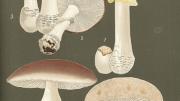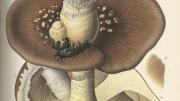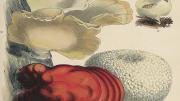North Americans on rambles through the woods may come upon any of thousands of species of wild mushrooms. A very few are delicious. Probably none is more lethal than Amanita phalloides, the death cap. Ingesting it causes cell necrosis, especially in the liver and kidneys. Although scientists have learned the formulas of its toxins, no antidote exists. Death occurs in 20 percent to 30 percent of cases. Although now widespread in North America, the mushroom is not indigenous and may have been imported from Europe among cork or oak tree seedlings. It is a mycorrhizal fungus, often found growing among the roots of oaks. Campers, do not sauté a mess of these for dinner.
Instead, see an online exhibit devoted to the death cap at www.huh.harvard.edu/ libraries/Amanita_exhibit/ intro.htm. Consisting of materials from the Farlow Library and Herbarium of Cryptogamic Botany, the exhibit explores the naming of the fungus, poisonings by it from Australia to Alabama, the way it has been shown in botanical illustration from 1727 onward, and its appearances in literature and even music. The culprit is shown at left in Thomas Taylor’s Student’s Hand-Book of Mushrooms of America Edible and Poisonous (Washington, D.C., 1897).
The library has also mounted an online exhibit of images documenting the history of mycological illustration (see www.huh.harvard.edu/libraries/ mycology/illustration.htm). It begins with the very first published depiction of a fungus, a woodcut from 1491, and goes on to show how advances in the technology of image reproduction led to increasing precision in illustration. Among the earliest works to be printed using lithography was Illustrations of the Fungi of Our Fields and Woods (London, 1864-65), by Sarah Price (at right), and one of the finest was Émile Boudier’s Icone Mycologicæ (Paris, 1905-10). Its image of Cortinarius is reproduced here (at top). Several species in this huge genus are poisonous, but if you’re thinking of doing someone in, you might as well stick to amanita, remembering Isaac Asimov’s advice, in Ellery Queen’s Mystery Magazine, that “A salad with diced amanita/Will kill with the speed of a cheetah.”










